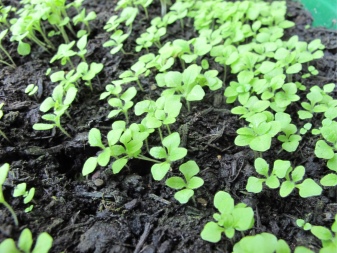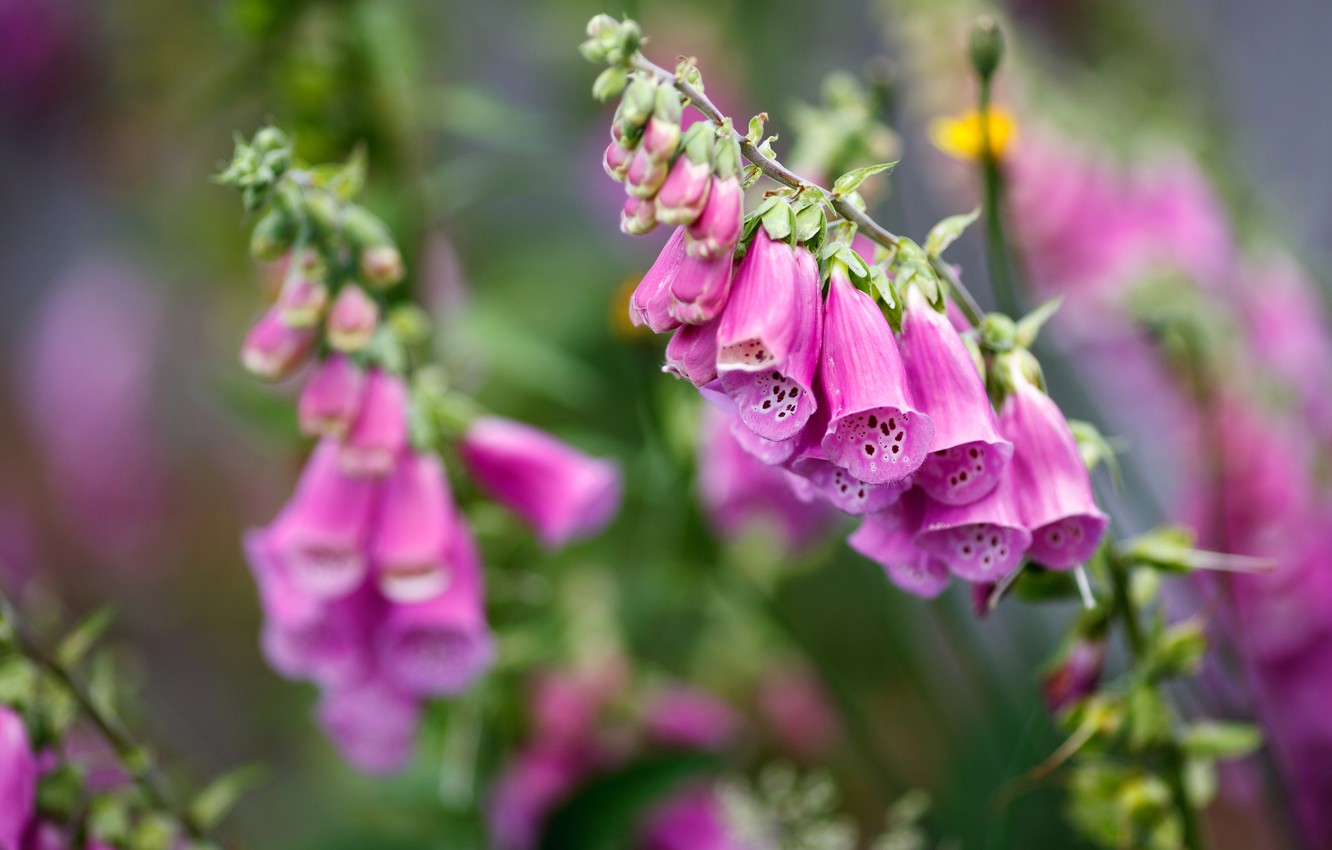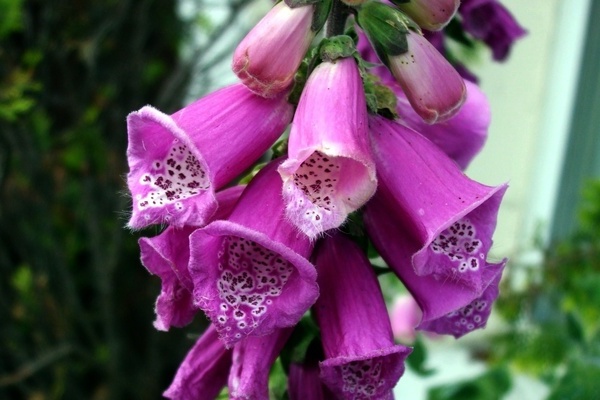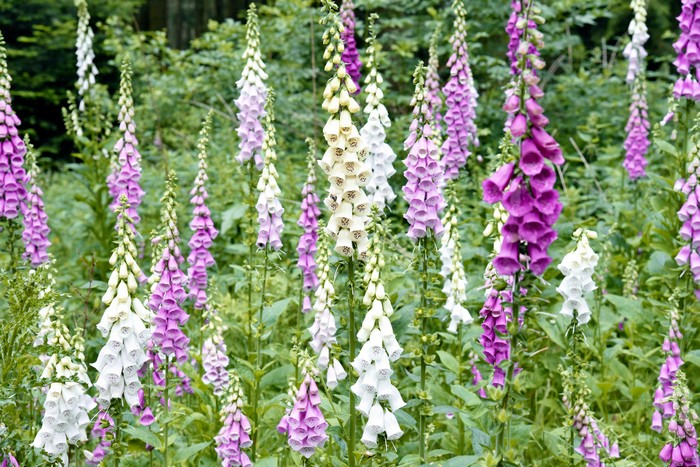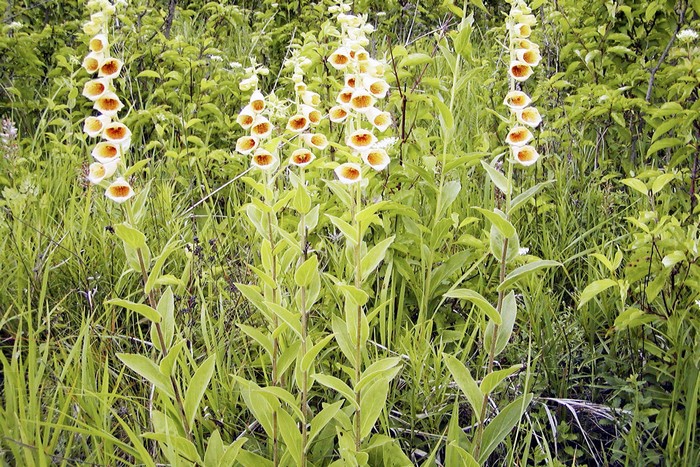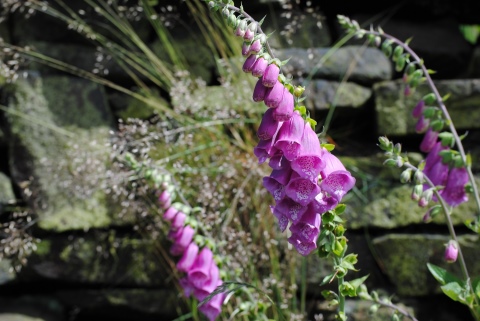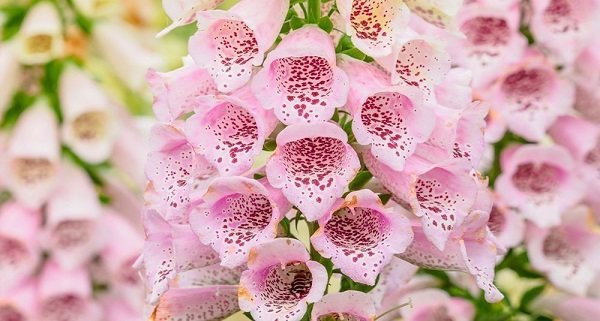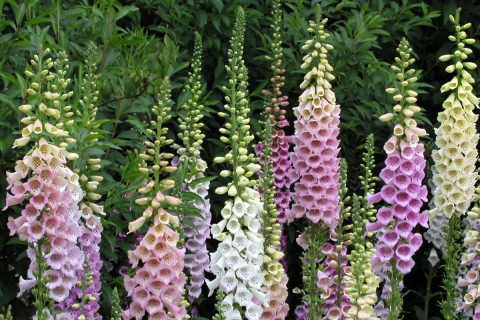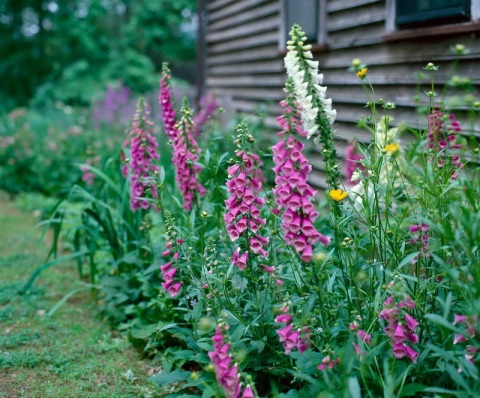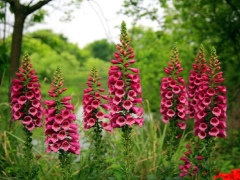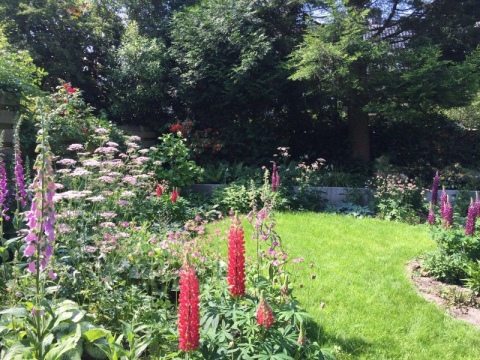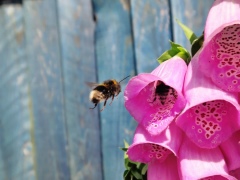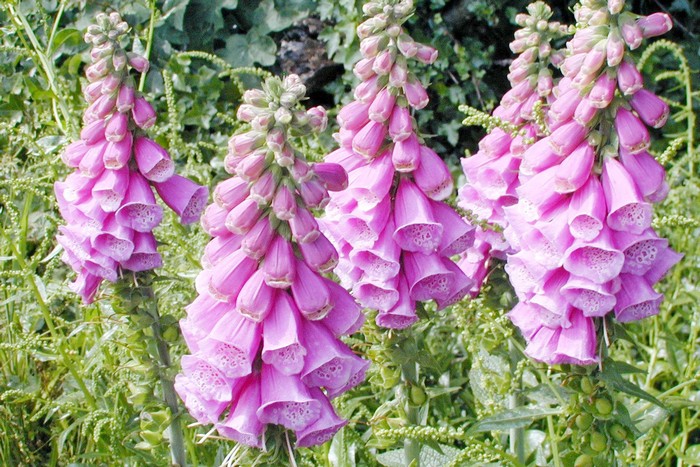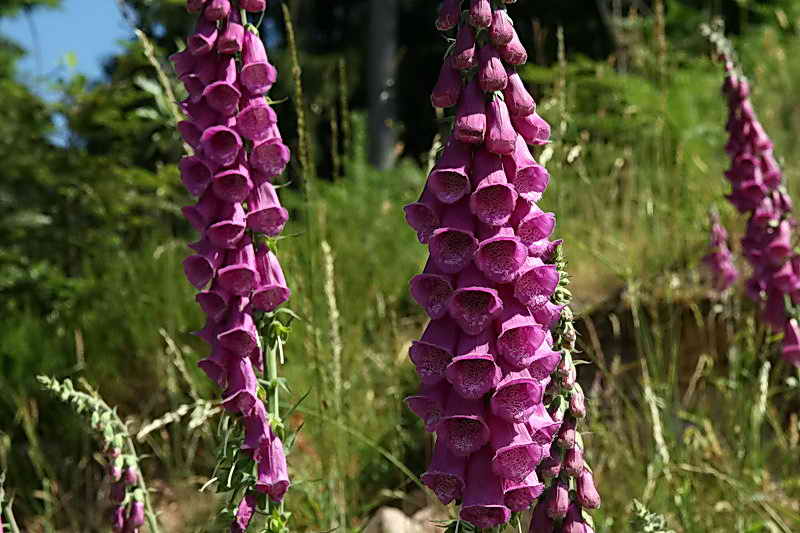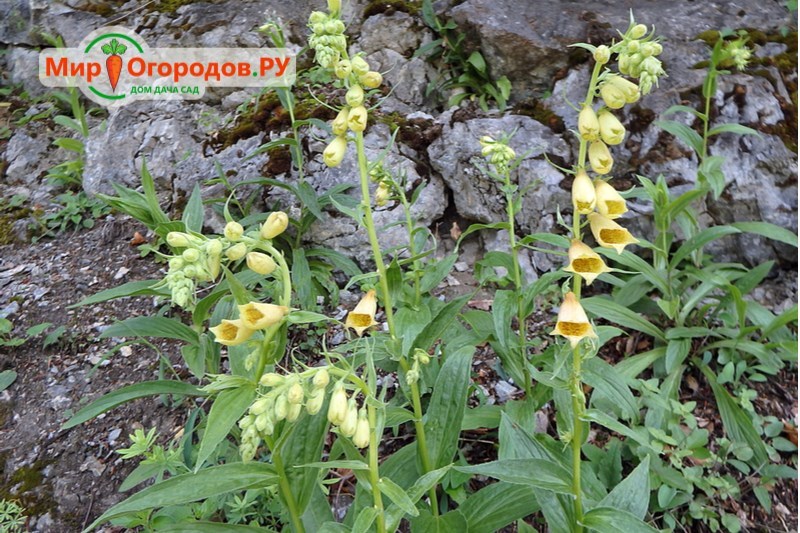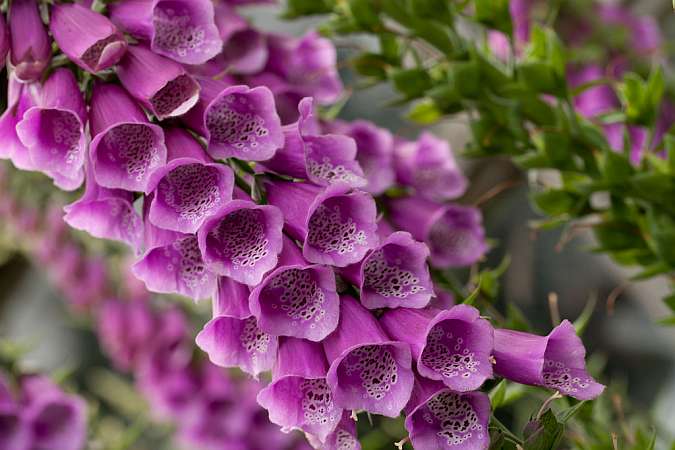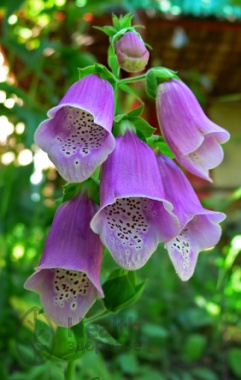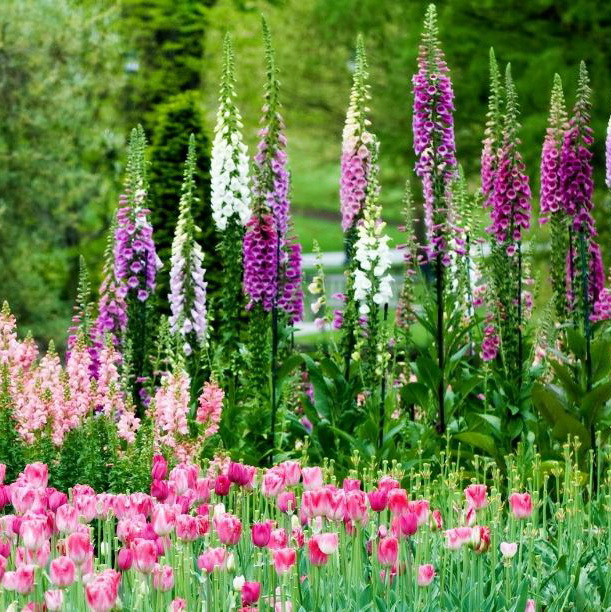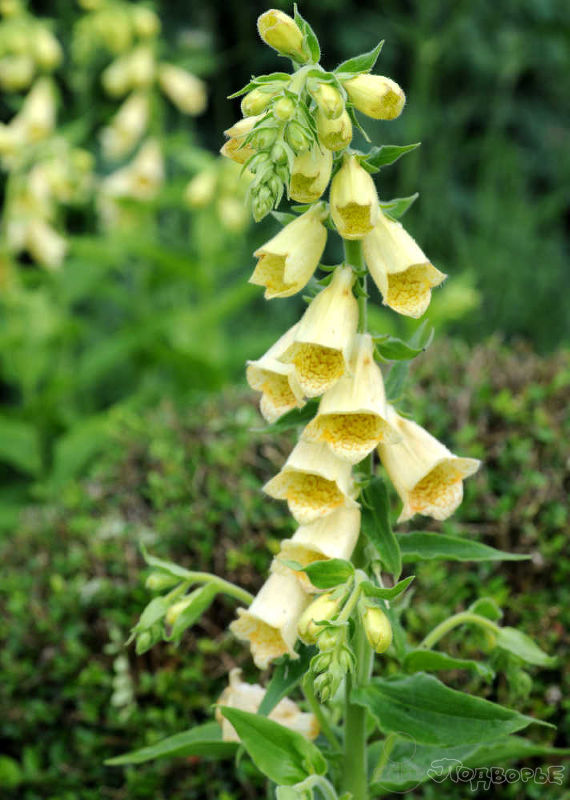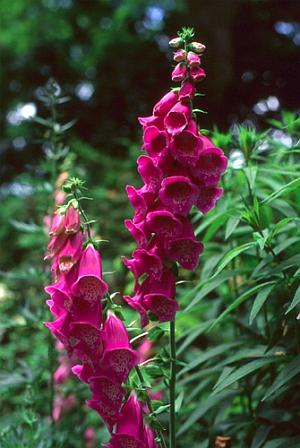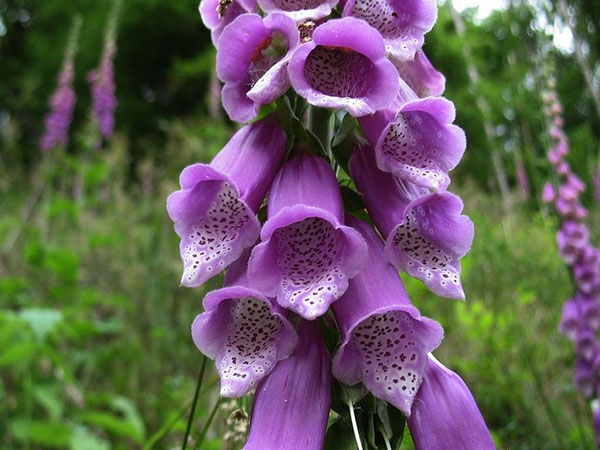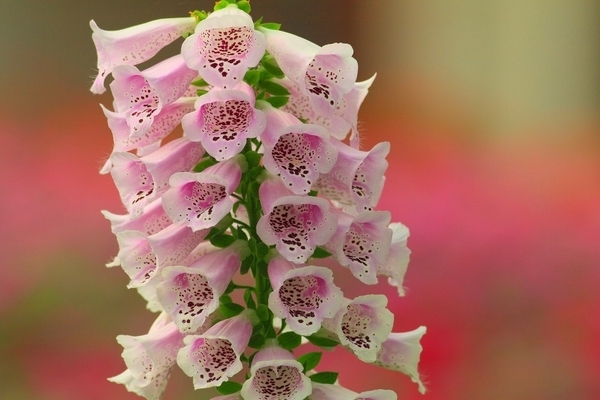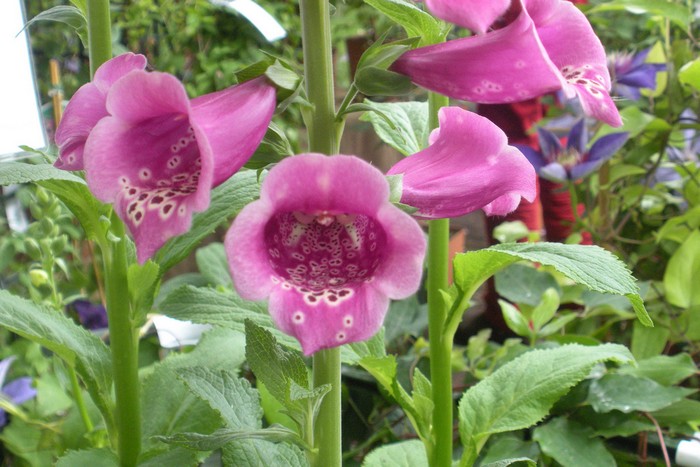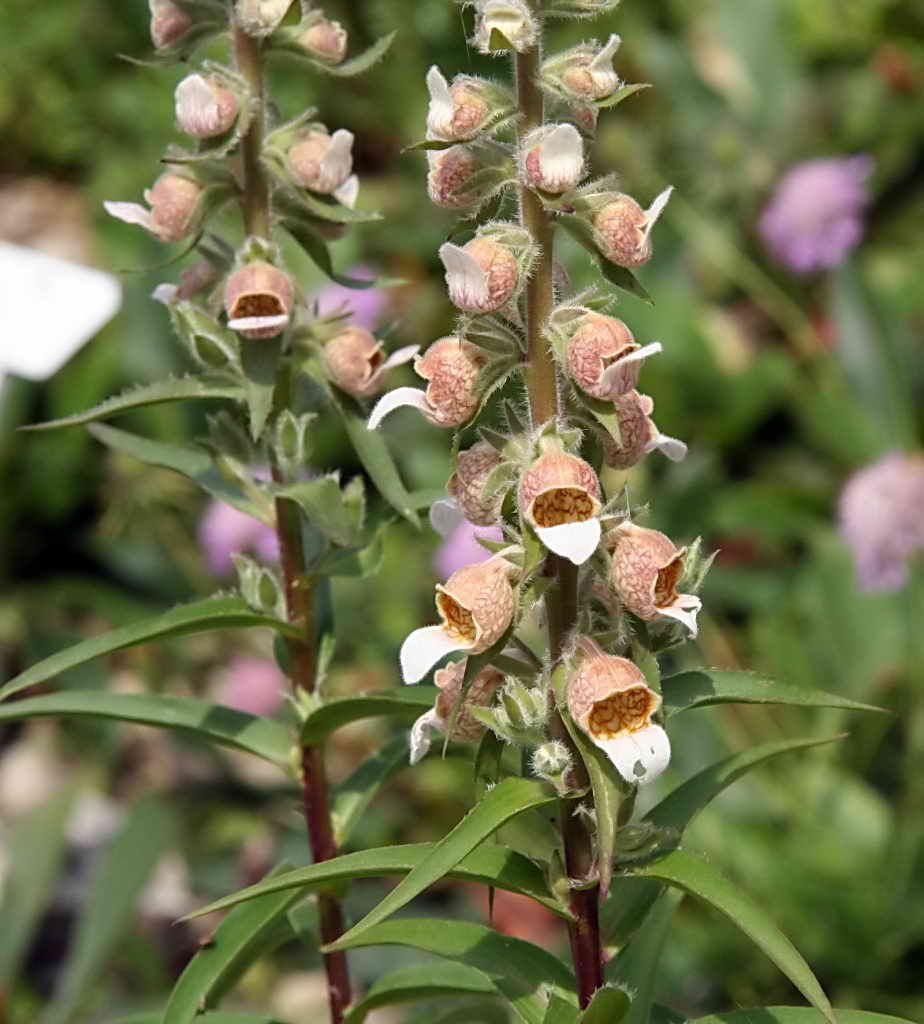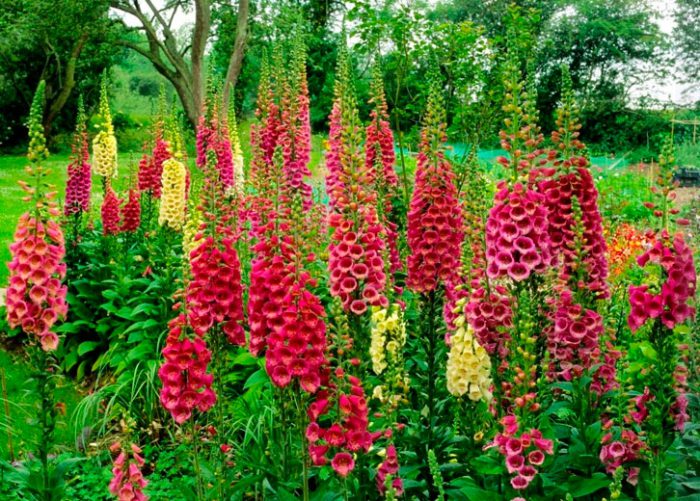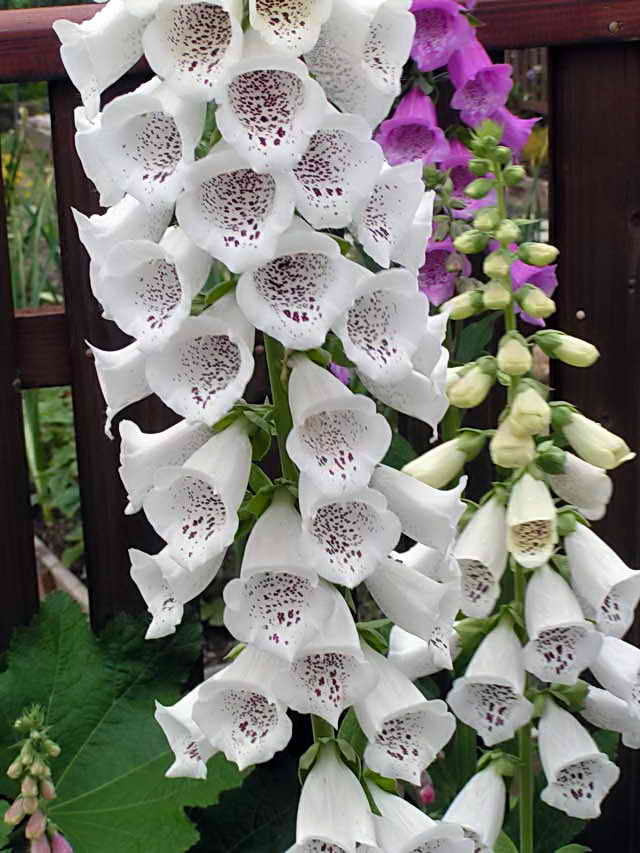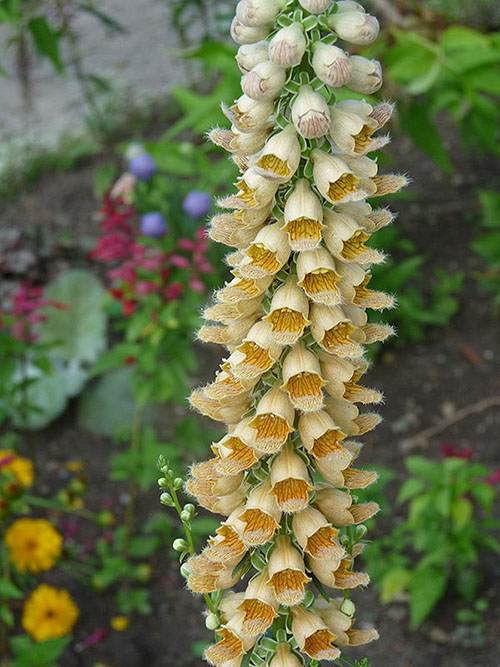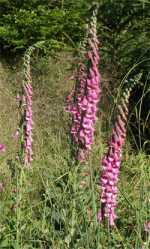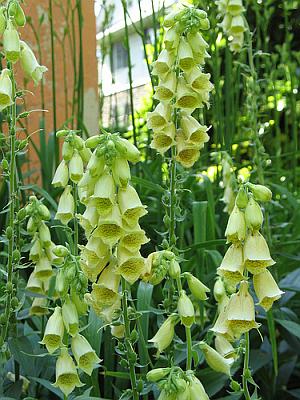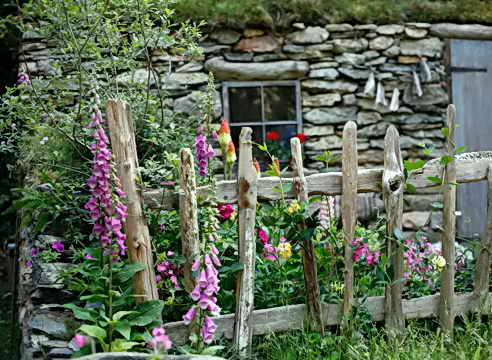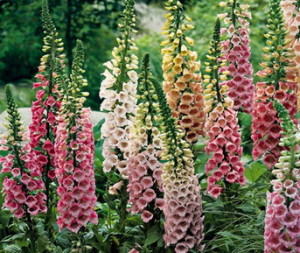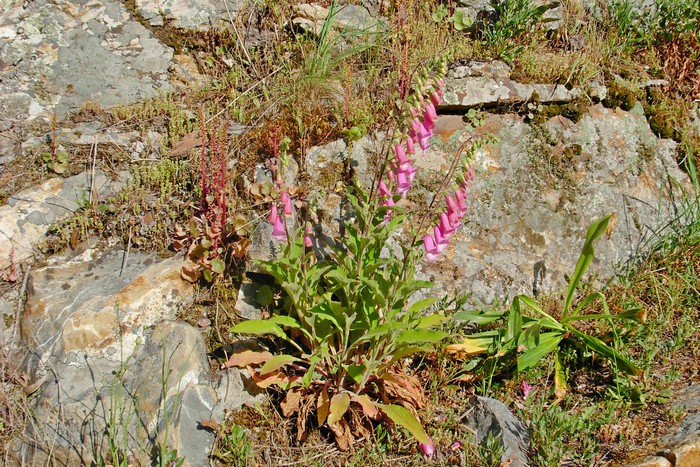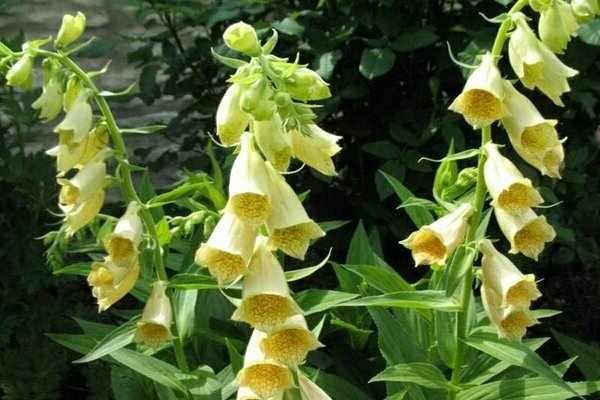Foxglove - species
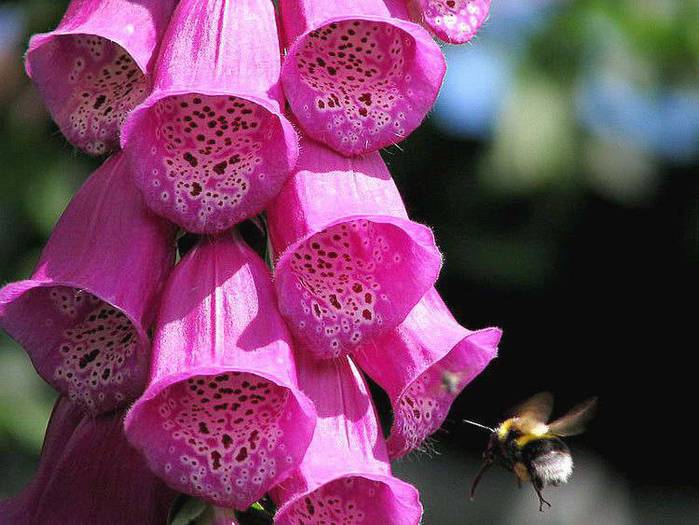
Foxglove purple
The foxglove purple is the most famous species. It belongs to tall plants and can reach 1.5 m in height. It is grown as a biennial plant, since in the 3rd year it dies in the first year. The purple foxglove forms only a rosette of oval and rough leaves. But in the second year, spectacular long inflorescences, towering over a beautiful rosette, are a very beautiful sight. The color of flowers of various colors decorates the flower bed for 1.5 months. If you remove the faded inflorescences, then the new flower arrows will bloom in a second wave.

Foxglove large-flowered
Large-flowered digitalis - does not exceed 1.2 meters in height. The leaves are completely different from those of their predecessor: lanceolate, slightly pubescent with veins along the edge. Flowers, slightly drooping light yellow, up to 6 cm in size. Large-flowered foxglove blooms in June-July in the second year. They grow it as a biennial.
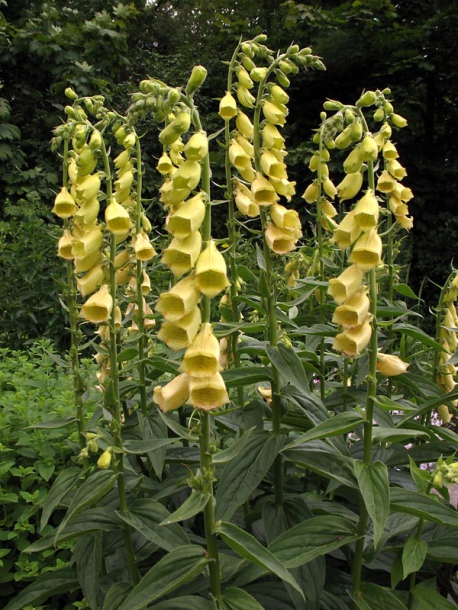
Foxglove yellow
Foxglove yellow - winters well. It grows up to 1 meter, the stems of the yellow foxglove are without pubescence, and the flowers bloom 2.5 cm in length.The flowers are pure yellow in color, sometimes with brown blotches along the pharynx. This species of foxglove blooms from June to August. Grown as a perennial, i.e. can grow in one place for several years.
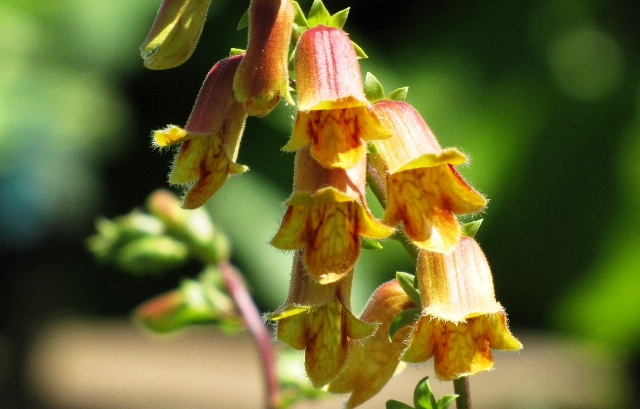
Foxglove rusty
Rusty foxglove is a very decorative species, sometimes it grows taller than human growth, but the average size is 1.2 meters. The flowers are a bit like orchid flowers, they have different color variations. Numerous flowers up to 4 cm, collected in spectacular inflorescences. This perennial plant sometimes behaves like a biennial. Rusty foxglove blooms in the second year, winters well.
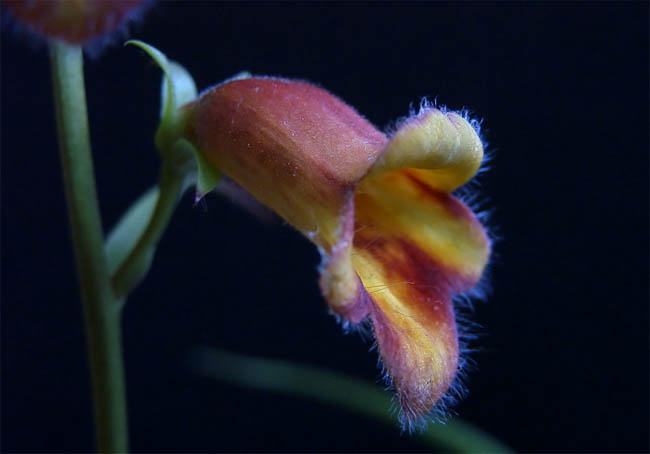
Foxglove obscure
Foxglove obscure or foxglove dark - an interesting name, isn't it? This rare plant, only 0.5 meters high, is found only among collectors. The flowers of the dark foxglove are tubular with pubescence, collected in racemose inflorescences. Coloring from creamy yellow to brownish-red colors. Blooms from July to September, tolerates drought well.
Keep in mind: Digitalis are poisonous garden plants!
Beautiful lupine candles
Shade-loving plants
Delphinium perennial
Types and varieties
Let us consider in more detail the existing varieties of digitalis.
Purple
A very beautiful and popular plant. The length of its stem reaches 150 cm. The leaves form a rosette at the roots, the largest of them are located near the ground, and the higher they "rise" along the stem, the smaller they become. They are egg-shaped, dark green on the front side and silver on the back.
The inflorescence is racemose, very lush, and consists of many funnel flowers. Despite the fact that this variety is called purple, the color of its petals can be pinkish, and snow-white, and beige, and lilac.

Many varieties of purple foxglove have been bred. You can familiarize yourself with them below.
The Shirley. The height of the stem is up to 150 cm, the color of the petals is snow-white, pale cream or pinkish. Bell-shaped flowers are collected in a racemose inflorescence.


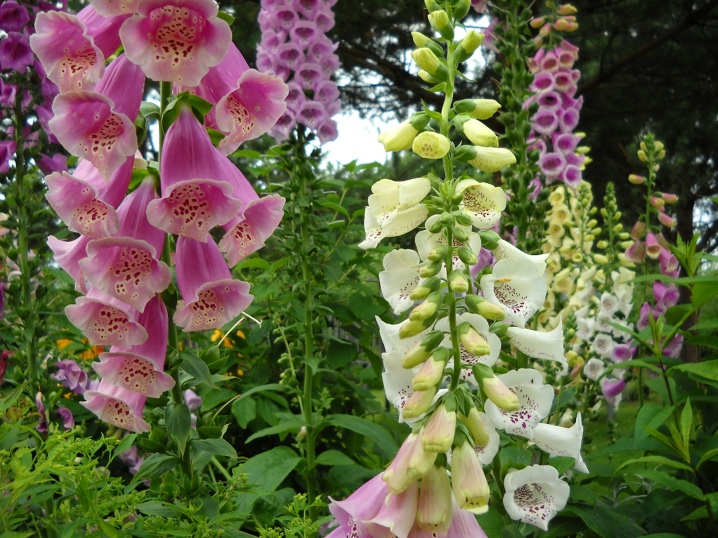
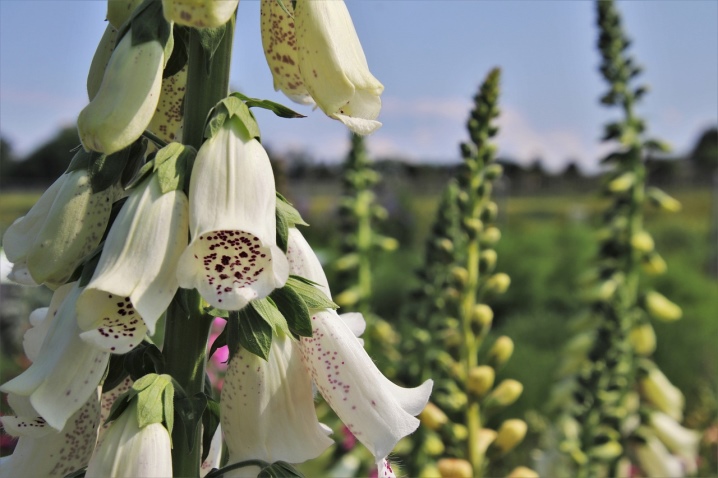


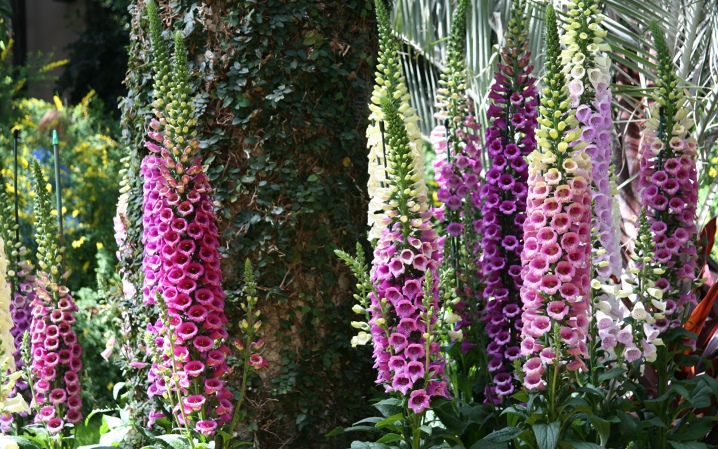
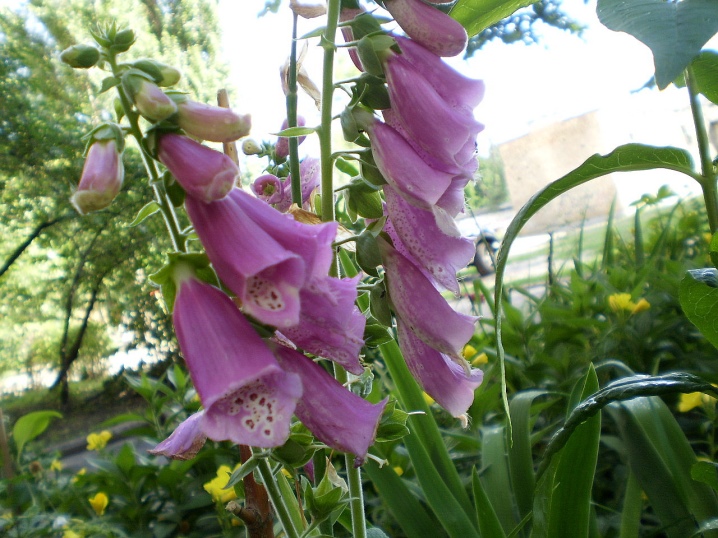
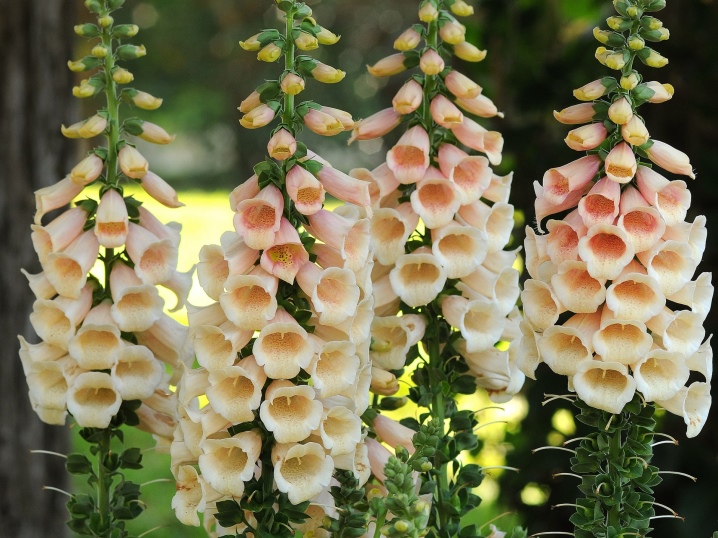
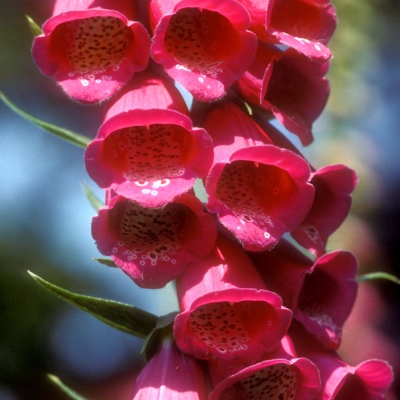
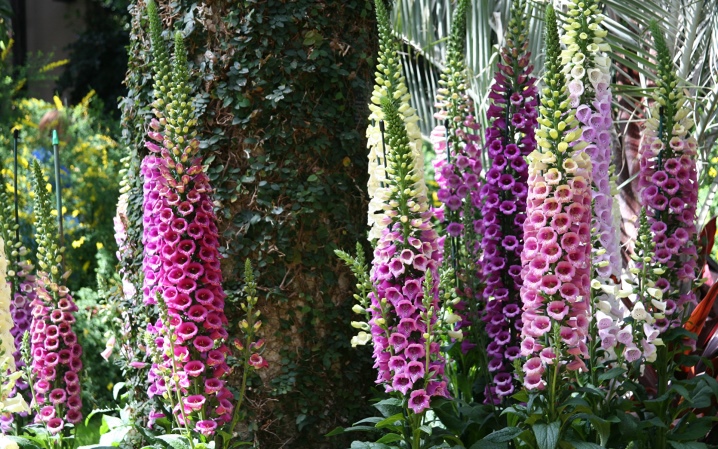
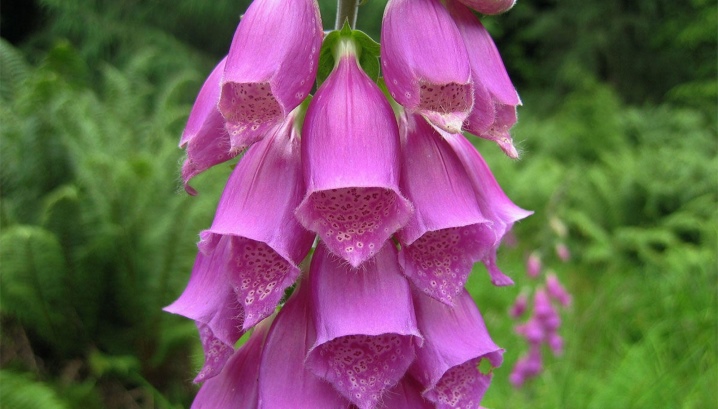
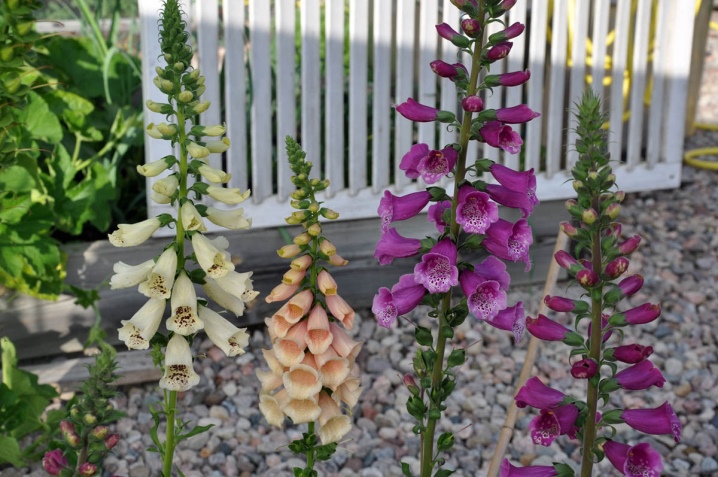
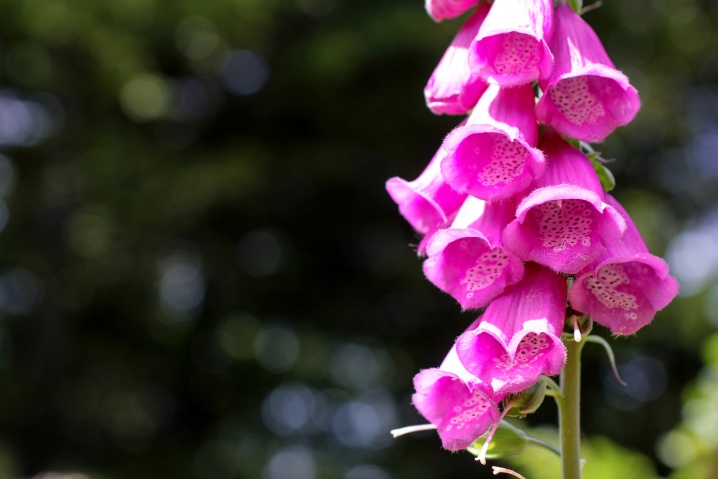
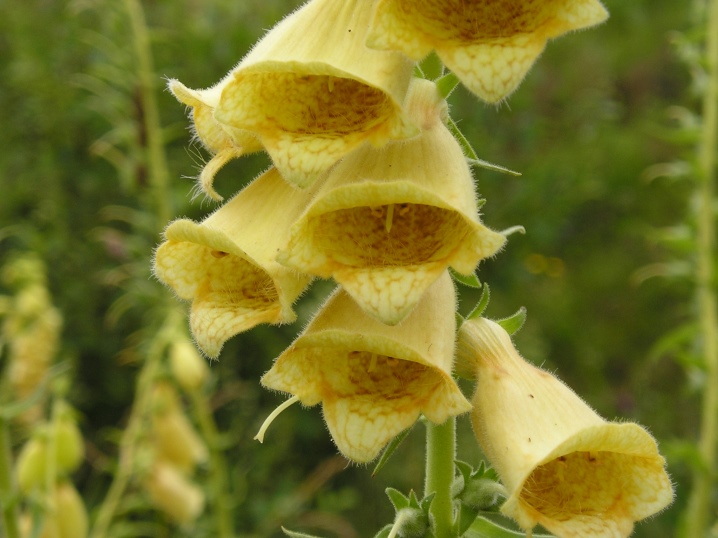

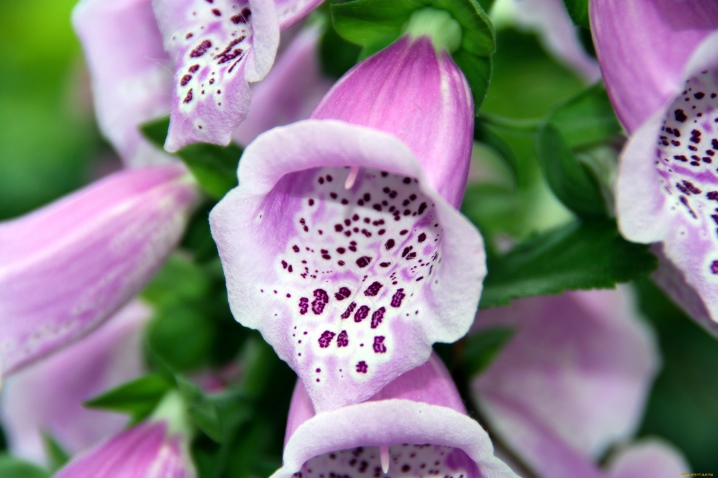
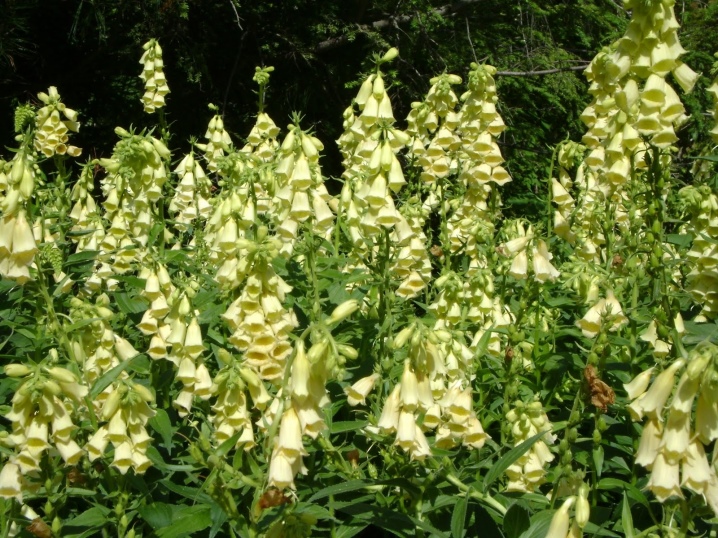
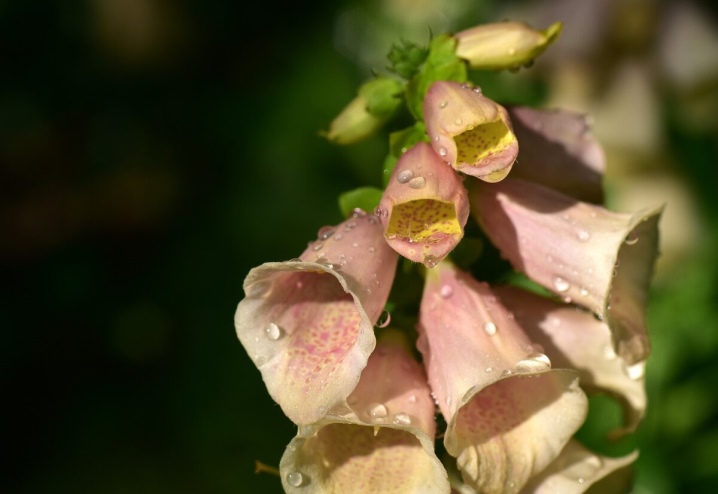

Large-flowered
Not too tall (up to 70 cm) perennial plant. Elongated bell-shaped flowers are collected in sparse one-sided inflorescences. The color of the petals is pale yellow, there are inclusions from the inside. Known for its shorter variety - Dwarf Carillon, reaching 40 cm in height. The color of the petals is yellow.

Rusty
The unusual name is justified by an even more unusual color - light brown on the outside and a little darker on the inside.Moreover, the appearance of the flower is also unusual - it resembles the muzzle of some animal with an open mouth and a protruding tongue. The color may vary slightly depending on the variety, for example:
- Gigantea - the petals are darker, resemble black tea diluted with milk, and the stem height is 150 cm;
- Gelber Herold - flowers have a yellow-green undertone, the height of this variety is 130 cm.
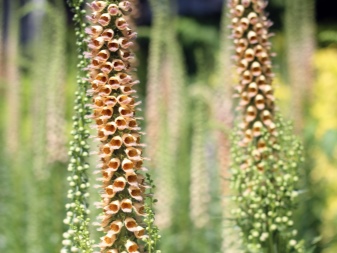

Woolly
This type of digitalis reaches a height of 30-80 cm, has slightly pointed oblong ovoid leaves. Small lanceolate leaves are also present on the stem. The inflorescence is a large densely pubescent tassel, the flowers are yellowish-brown with a white "tongue" and a spherical swollen corolla.
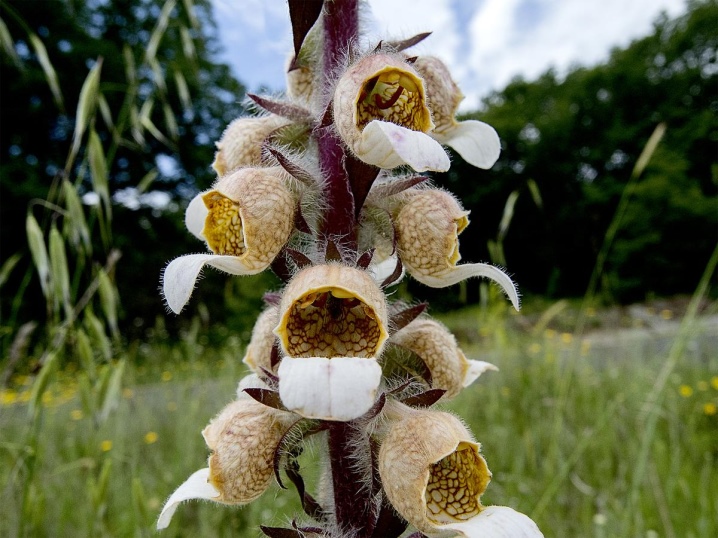
Ciliated
Not a very common type. Tall plant reaches about 60 cm, several stems grow from one rhizome. Digitalis ciliate leaflets are pointed, their edges are serrated. The inflorescence is very small compared to other varieties, the flowers are bell-shaped, white-pink with yellow, small. The plant is considered an excellent honey plant.
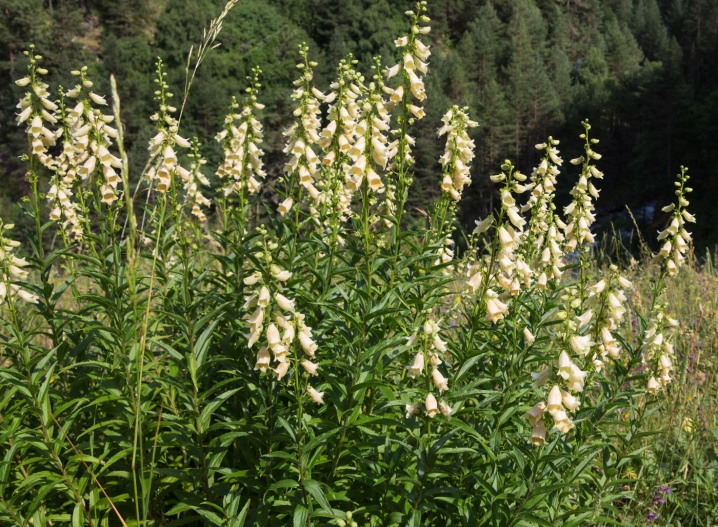
Yellow
A beautifully flowering variety of digitalis. The stem of the plant is fleshy, erect, reaches a height of 100 cm. The inflorescence is pyramidal, racemose, collected from large bell-shaped yellow flowers. The most popular variety is “Gelb Janus” 80-100 cm high. The color of its petals is pale yellow.

Hybrid
Breeders could not ignore such an attractive plant, so many new varieties were bred. Here are the most popular ones.
Excelsior Hybrids Mixed is a purple foxglove hybrid. Its height reaches almost 200 cm, and large bell-shaped flowers (white, pink or red) are located on the stem in a spiral.
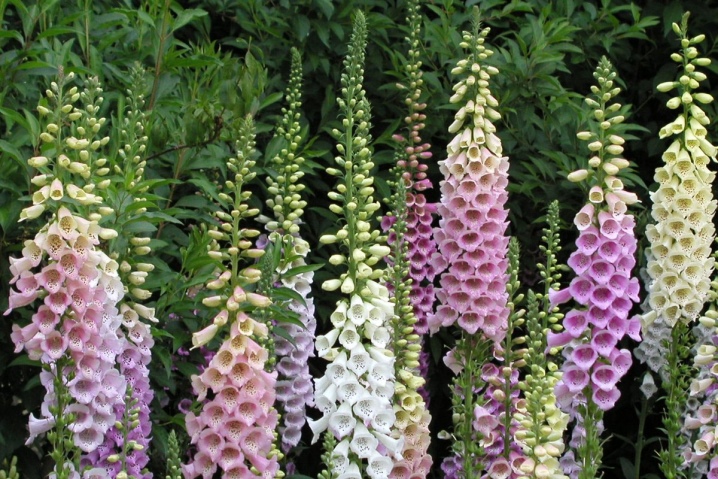
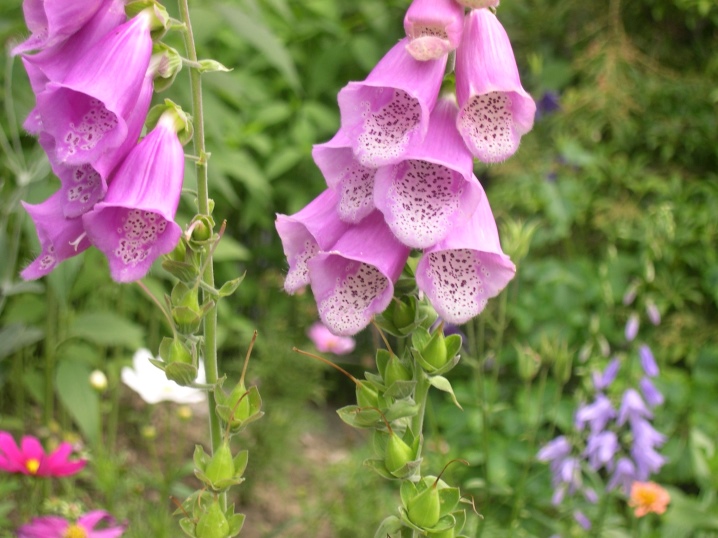
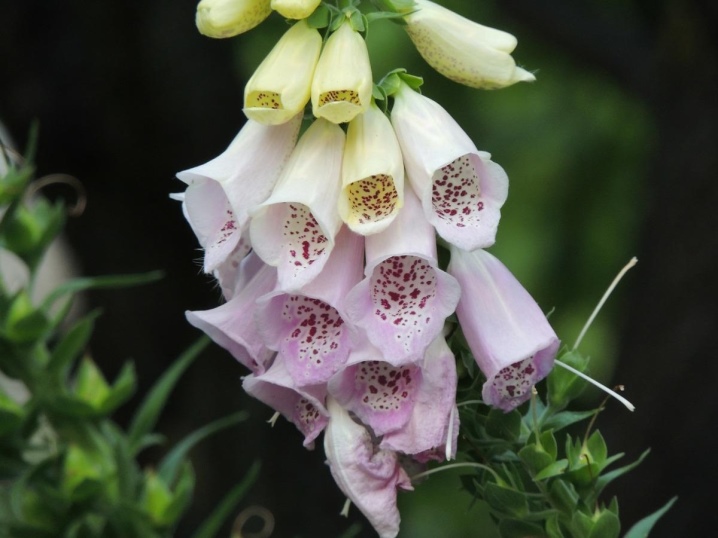
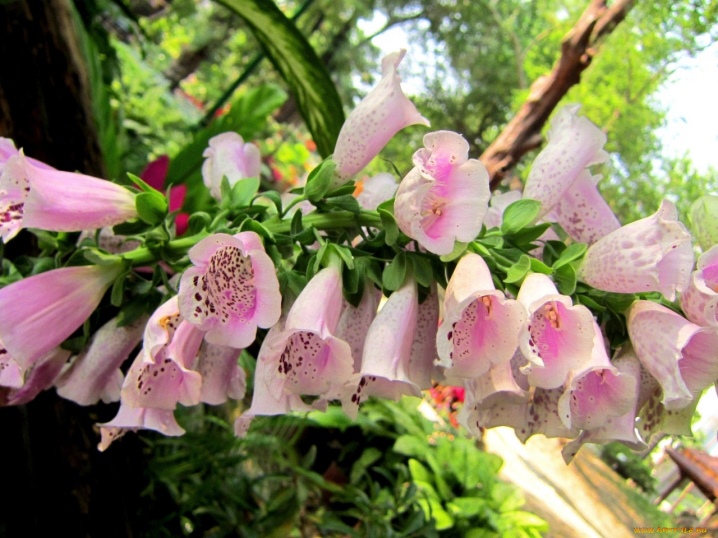
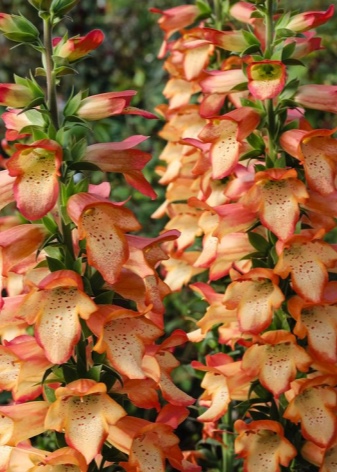
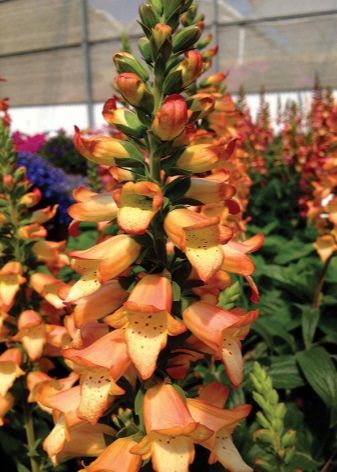
Landing in open ground
Grown from seeds and grown seedlings are planted in the garden after warm weather sets in and the threat of frost has passed. By this time, the bushes should have at least five to six leaves.
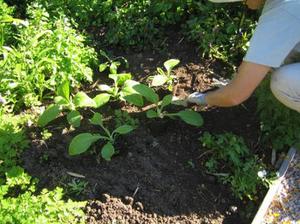
For growing digitalis, sunny or semi-shady areas are selected. Experienced gardeners do not recommend planting a flower under deciduous trees. Under the fallen leaves, the soil dries out poorly, which can lead to the lack of digitalis flowering or even rotting of its roots.
The soil for growing a plant must be moisture-permeable, fertile and loose. About two weeks before planting, the garden bed should be dug up and humus or compost should be added to the soil (for 1 sq. M. - 4 kg). The distance between the rows for plants should be about thirty centimeters, and between the bushes - from fifteen to twenty centimeters.
Plants are placed in the prepared holes along with a lump of earth, after which their roots are covered with soil and watered. Foxglove will bloom only next year. In the year of planting, only rosettes of leaves will form on the bushes.
Growing digitalis from seeds, planting and caring for the plant
Foxgloves reproduce by seeds. We sow seeds in simple greenhouses without heating or directly to summer cottages (by warmth) in late May-early June. Shoots are 7-11 days. First, we thin them out a little, when the plant forms two pairs of true leaves, so that it is easier for them to grow. If the seedlings of flowers were grown at home, then the pick is carried out either in greenhouses (we cover them with non-woven material if the weather is pretty cool), or immediately to the beds.
We plant in open ground
When transplanting digitalis from greenhouses to a permanent place of residence at the end of summer (roughly mid-August), we adhere to a distance between plants of 40-50 cm. If we sow seeds in beds, then we sow more often, with a margin. After a while, we pinch part of the sprouts in such a way that there is the above distance between the remaining flowers.But only by the end of spring and early summer of the second year of life, the planting of foxglove blooms, more often in June, starting from the lower part of the inflorescence, that is, in the upper part of the spike there are young flowers.
Good soil and high agricultural technology significantly increase the decorative effect of plants, but in autumn, a strong development of a leaf rosette should be avoided, leading to damping in winter. Since the flowers are cross-pollinated, the spatial isolation of different species is necessary for digitalis when growing. We mark the best specimens in advance in order to collect seeds from them when they ripen. Seeds remain similar for 2-3 years.
For winter storage
Foxglove purple can be transplanted into pots for home distillation in the spring, early. With this option, we store the plants from the end of summer in a cold room with a temperature of about 12 degrees. Under such comfortable conditions for digitalis, the first flowers usually appear in April.
Flowers in design
For a creative transformation of landscape design, digitalis dachas are best grown in large irregular groups on lawns, on the edges or in the central parts of the flower bed. Since they can easily withstand shade, plants. in contrast to the sun-loving celosia, they are often planted between trees. Foxglove flowers can stand in water for a long time, while retaining freshness and therefore represent an excellent material for creating bouquets.
Foxglove purple is a poisonous plant. In addition to its decorative value, it is of great importance in medicine. Digitalip is extracted from its leaves - a powerful heart medicine.
The choice of which types of foxglove to grow is always yours alone, we only guarantee that these plants will bring only joy.
Dosage forms
The red, purple and large-flowered herb foxglove, whose medicinal properties have an immediate effect on the body, allows you to quickly relieve negative symptoms by taking medications in emergency situations. These include: "Digitoxin", "Gitoxin" and "Cordigit" in tablets, "Gitalen" in solution and green powder from the dried leaves of the plant. In terms of chemical composition and action on the human body, rusty foxglove is almost identical to its purple "friend". The solutions that are produced today by the pharmaceutical industry based on this plant are called "Digalen-Neo" and "Sukkudifer". Woolly foxglove, the effect of which on the heart and blood vessels has a lesser cumulative (cumulative) effect, is safer for the body even with prolonged use. Taking drugs based on it in medical (recommended) doses rarely leads to toxic side effects.
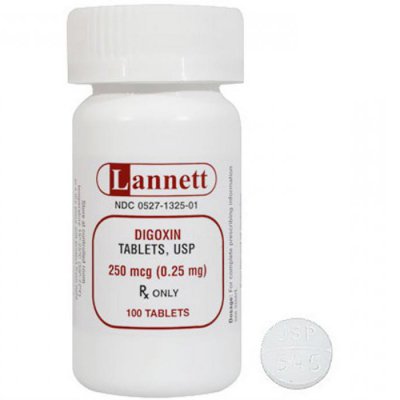
Digoxin tablets are the most common medicine for heart ailments abroad. The raw materials for its manufacture are foxglove leaves rusty. In addition to this drug, today in the pharmacy you can also find "Celanide" (powder), tablets - "Abicin" and "Acetyldigitoxin", solutions - "Dilanizid" and "Lantosid" (alcohol).
Digitalis: species, varieties
Digitalis is a beautiful plant with about 11 varieties
Each of them has an original color, beautiful flower shape and definitely deserves attention. The following are the most popular varieties
Rusty foxglove (Digitalis ferruginea)
It has a high decorative effect. It forms shoots whose height reaches 70-120 cm. It is covered with lanceolate and oblong bare foliage.
Rusty foxglove (Digitalis ferruginea)
Long, about 7-15 cm inflorescences consist of bells, the edges of which are framed by a beautiful wave. The calyx resembles an orchid and reaches a length of 4 cm. It has two-lipped tips with a pronounced lower lapel. The petals are light yellow. They have a pink pattern on the lip and a brownish-gold pattern on the inside of the throat.
This culture blooms throughout the warm season, from June to August.
Purple digitalis (Digitalis purpurea)
The plant is biennial. In rare cases, perennials are found.Reaches a height of 1.5 m. Stems are erect and slightly branched. Casting in the lower part, like the shoots, densely lowered. Petiole leaves are oval.
Purple digitalis (Digitalis purpurea)
In June, a one-sided or pyramidal inflorescence begins to bloom, which has the shape of a brush, consisting of asymmetric flowers. Their length ranges from 8 to 13 cm.The petals are purple, white at the base. Covered with dark spots.
Popular varieties of foxglove of this species:
- Alba. It has snow-white petals, dotted with small dark purple dots.
- Mirabella. With multi-flowered dense inflorescences that have a cream or salmon color.
Large-flowered foxglove (Digitalis grandiflora)
The plant of this species forms a semi-shrub up to 120 cm high. The stems of the plant are covered with glandular, rather stiff villi.
Large-flowered foxglove (Digitalis grandiflora)
Along the entire length of the shoot, lanceolate petiolate foliage with a light green tone grows. The leaves are elongated and sharp edge. Leaves can be up to 25 cm long and 7 cm wide.
In mid-June, a long brush 6-25 cm long blooms at the top of the shoot. It is on it that tubular flowers 3-4 cm are located. The edges of the corolla are equipped with five bent petals. The flowers are gray-yellow with small brown dots inside.
Foxglove woolly
The culture is perennial. It reaches a height of 80 cm. It forms a dense rosette near the ground cover, consisting of lanceolate foliage of a bluish-green color. The edge of the foliage on the underside is covered with long eyelashes.
Foxglove woolly
In July, the plant dissolves a pyramidal brush. Two-lipped cups grow quite densely on it. The petals and bracts are also pubescent with a silvery felt pile. The tube of the flower reaches 2-3 cm in length. Petals 1 cm long protrude beyond the edges of the tube.
The colors are cream or white. At the center it is covered with a pattern of veins of a yellowish-brown hue.
Small-flowered digitalis (Digitalis parviflora)
A biennial plant native to Spain and Portugal. The stems are crowned with elegant inflorescences with small, funnel-shaped, chocolate-colored flowers. The Milk Chocolate variety is known.
Small-flowered digitalis (Digitalis parviflora)
Strawberry-flowered foxglove (Digitalis x mertonensis)
A hybrid whose flowers are distinguished by the exquisite color of pureed strawberries. Plant height - about 75 cm. The Summer King variety is known.
Strawberry-flowered foxglove (Digitalis x mertonensis)
Digitalis Saltwood Summer
Orchid foxglove. The plant got its name from the shape of white flowers with bent petals in a red speck, which resemble an orchid. The plant was introduced by Hilliers Nurseries at the Chelsea Garden Show in 2002. Plant height - up to 1.5 m.
Digitalis Saltwood Summer
Foxglove hybrids
There are many interspecific perennial digitalis hybrids available for garden cultivation. The most popular among them are:
- Tapsi - gray-green leaves adorn straight stems 40-80 cm high, on their top there are dense clusters with large bells of pink or crimson color;
- Merton - a plant 60-80 cm high is decorated with bright green long leaves, it blooms in May with large mauve flowers.
Foxglove hybrid
Landing rules
There are two ways to plant digitalis in open ground: pre-grow seedlings or sow seed. Let's consider both options.
Seedling
The young animals are disembarked on the personal plot after the establishment of a plus average daily temperature at the end of May or at the beginning of June. The soil is already warmed up enough by this time, and there are 5-6 leaves on the seedlings.
It is preferable to grow digitalis in areas with sunlit, but slightly shaded areas are also suitable. Planting under trees shedding foliage in the autumn is not recommended, since moisture lingers in the trunk circles for a long time, and the digitalis will suffer from waterlogging, which is fraught with a lack of flowering.
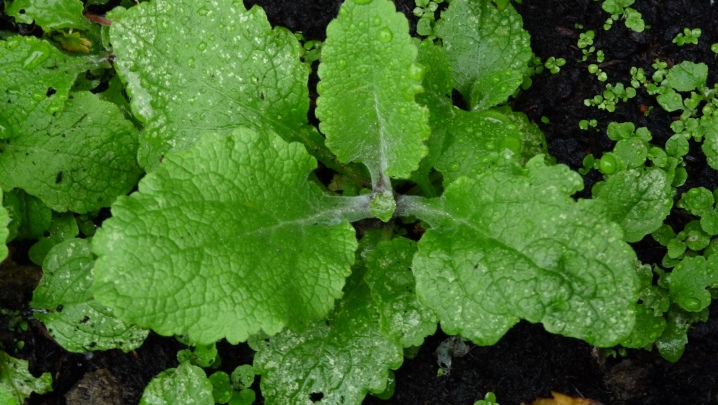
Seedling planting rules:
- select a site with fertile moisture-permeable soil;
- loosen it in advance to the depth of a shovel bayonet, while simultaneously adding 4 or 5 kilograms of compost fertilizer for each square meter;
- plant the plants, observing an interval between them of 15-20 cm with a row spacing of 25-30 cm;
- planting by transferring seedlings into prepared holes from containers along with a lump of earth;
- compact the soil, water the seedlings.


Seeds
Sowing seed in open soil is done in early spring - the end of March or early April is suitable.
Algorithm of actions:
- prepare the bed in advance: loosen the soil, level it with a rake;
- form shallow rows with a planting depth of up to 2 cm and a distance of 25-30 cm between them;
- do not thicken the planting, keep the spacing between the seeds;
- cover the planting with soil;
- if it is cool outside, it is recommended to cover the bed with lutrasil;
- after sprouting, thin them out, keeping the distance between seedlings 8-10 cm;
- you need to transplant plants to a permanent place at intervals of 20-25 cm or 40-50, depending on what you want to get in the end: a single planting or a flower row.

